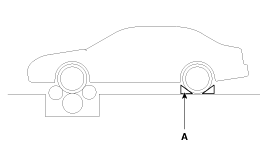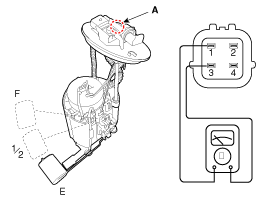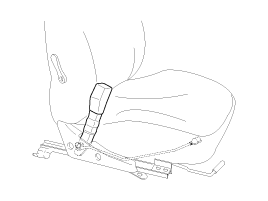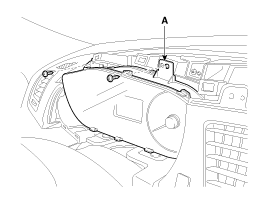Kia Cadenza: Indicators And Gauges / Instrument Cluster Repair procedures
Kia Cadenza YG 2016-2025 Service Manual / Body Electrical System / Indicators And Gauges / Instrument Cluster Repair procedures
| Inspection |
Speedometer
| 1. |
Adjust the pressure of the tires to the specified level. |
| 2. |
Drive the vehicle onto a speedometer tester. Use wheel chocks (A) as appropriate. |
| 3. |
Check if the speedometer indicator range is within the standard values.
[km/h]
[MPH]
| ||||||||||||||||||||||||||||||||||||||||||||||||||||||||
Tachometer
| 1. |
Connect the GDS to the diagnostic link connector or install a tachometer. |
| 2. |
With the engine started, compare the readings of the tester
with that of the tachometer. Replace the tachometer if the tolerance is
exceeded.
|
Fuel Sender
| 1. |
Using an ohmmeter, measure the resistance between terminals 1 and 3 of sender connector (A) at each float level.
|
| 2. |
Also check that the resistance changes smoothly when the float is moved from "E" to "F"
[Standard - Gasoline]
[Supervision - Gasoline]
|
| 3. |
If the height resistance is unsatisfied, replace the fuel sender as an assembly.
|
Brake Fluid Level Warning Switch
| 1. |
Remove the connector (A) from the switch located at the brake fluid reservoir. |
| 2. |
Verify that continuity exists between switch terminals 1 and 2 while pressing the switch (float) down with a rod.
|
Brake Fluid Level Warning Lamp
| 1. |
Ignition "ON" |
| 2. |
Release the parking brake. |
| 3. |
Remove the connector from the brake fluid level warning switch. |
| 4. |
Ground the connector at the harness side. |
| 5. |
Verify that the warning lamp lights. |
Parking Brake Switch
The parking brake switch (A) is a pulling type. It is located
under the parking brake lever. To adjust, move the switch mount up and
down with the parking brake lever released all the way.
| 1. |
Check that there is continuity between the terminal and switch body with the switch ON (Lever is pulled). |
| 2. |
Check that there is no continuity between the terminal and switch body with the switch OFF (Lever is released).
If continuity is not as specified, replace the switch or inspect its ground connection.
|
Door Switch
Remove the door switch and check for continuity between the terminals.
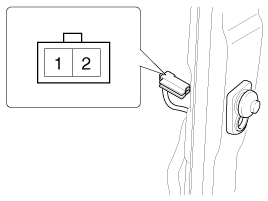

Seat Belt Switch
| 1. |
Remove the connector from the switch. |
| 2. |
Check for continuity between terminals.
|
Seat Belt Warning Lamp
With the ignition switch turned ON, verify that the lamp glows.
| Seat belt condition | Warning lamp |
| Fastened | OFF |
| Not fastened | ON |
| Removal |
Instrument Cluster
| 1. |
Disconnect the negative (-) battery terminal. |
| 2. |
Tilt the steering column down. |
| 3. |
Remove the cluster facia panel after removing the screws.
(Refer to Body - "Crash Pad") |
| 4. |
Remove the instrument cluster (A) after loosening the screws.
|
| 5. |
Disconnect the cluster connector (A), then remove the cluster.
|
Speaker
| 1. |
Remove the crash pad lower panel.
(Refer to Body - "Crash Pad") |
| 2. |
Remove the speaker (A) after removing the screws (2EA) and connector.
|
| Installation |
Instrument Cluster
| 1. |
Install the cluster to the cluster housing. |
| 2. |
Install the cluster fascia lower panel. |
Speaker
| 1. |
Install the speaker after connecting the connector. |
| 2. |
Install the crash pad lower panel. |
 Instrument Cluster Schematic Diagrams
Instrument Cluster Schematic Diagrams
Circuit Diagram
...
 Troubleshooting
Troubleshooting
Troubleshooting
SymptomPossible causeRemedySpeedometer does not operateCluster fuse (10A) blownCheck for short and replace fuseSpeedometer faultyCheck speedometerCAN line faultyCheck the TCUWirin ...
Other information:
Kia Cadenza YG 2016-2025 Service Manual: SS-B Solenoid Valve(ON/OFF) Specifications
Specification ItemSpecificationControl typeON/OFFCurrent value (mA)5.0 Coil resistance(Ω)10 ~ 11 ...
Kia Cadenza YG 2016-2025 Owners Manual: To restart Smart Cruise Control
If any method other than the CRUISE button was used to cancel cruising speed and the system is still activated, the cruising speed will automatically resume when you move the RES+ switch up. If you move the RES+ switch up the speed will resume to the recently set speed. However, if ...
Copyright © www.kcadenzavg.com 2017-2025




